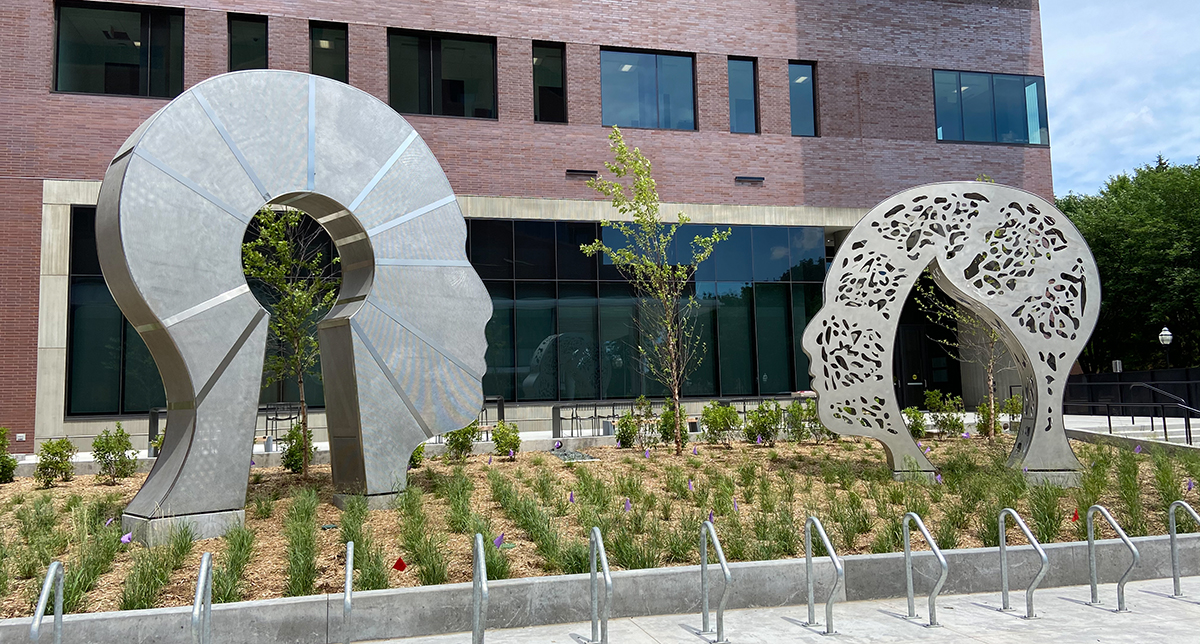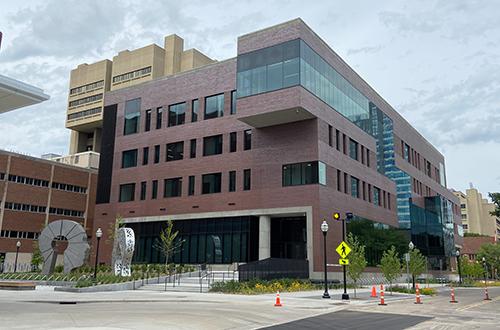A sculpture by Artist Barbara Grygutis is a highly visible addition to the University’s Health Sciences Education Center
With its focus on active, team-based learning in small-group environments, the Health Sciences Education Center (HSEC) has been designed to transform health education in Minnesota. The facility offers places to connect, collaborate and communicate across disciplines.
The spirit of the facility is brought to life through art. A specially commissioned sculpture was added to the University of Minnesota’s renowned public art collection, installed outside of the HSEC on the Twin Cities campus. Dialogue, a 3D visual sculpture by Grygutis, was designed with the goal that everybody who sees it is the intended audience, and that each viewer will take away personal meaning from that experience.
“The ability to have a conversation with people from different backgrounds is what this artwork represents,” said Grygutis. “I cannot imagine how important the concept of dialogue is to a health professional in this day and age, and yet it’s more universal than that. This artwork represents the concept of human beings really needing to talk to each other and understand their differences and how fundamental that is to our existence as human beings.”
Building community and meaning through art
The University of Minnesota Public Art on Campus Program was established in 1988. Today, the collection includes 29 pieces of public artwork on campus, according to Weisman Art Museum Public Art Curator Craig Amundsen.
“Public art is very much a community process,” said Amundsen. “Dialogue by Barbara Grygutis is a quintessential example of the kind of art that this program was created to produce. Her artwork will tell a story of the activities in the building—and this is what makes public art so valuable and brings meaning to our public spaces at the University.”
Grygutis has been creating art for nearly 40 years, first working with clay and ceramics and then moving to environmental works.
“As an artist, you want to design art that is relevant to where you are working and also has a universal message,” said Grygutis. “The concept of Dialogue is something that we need in our society and the whole idea of language is to have dialogue with another. In the context of health, I felt that this is an important message.”
According to Grygutis, Dialogue is designed to emphasize and highlight an important human interaction feature necessary for public health—the ability to listen and the ability to dialogue.
“Dialogue transcends our differences to find common ground,” said Grygutis.
The artwork includes two monumental sculptures crafted from aluminum, one 18 feet tall and the smaller at 14 feet, with integrated lighting. According to her artist statement, “the shape of each sculpture is a generalized, generic human head and does not convey gender or race—it is simply human.”
The two pieces are reflective of the natural daytime light and offer a subtle glow at night through lighting in a soft green hue.
“The sculpture will have visibility through all four of Minnesota’s seasons,” said Grygutis.
She hopes that Dialogue will cause people from all walks of life to pause and reflect.
“The other message of the artwork is that it doesn’t matter what size you are or what you look like, dialogue should transcend all of that,” said Grygutis. “Dialogue should unite us in our differences, which is a simplistic message, but fundamental to the human condition.”
As the University’s Public Art on Campus Program continues to grow, Amundsen is excited for the potential of Dialogue to give meaning to the public space surrounding the HSEC.
“Like all art, it will mean something different to each observer,” said Amundsen. “With its lighting and color, it’s going to be stunning. I think this piece will quickly become iconic art on our campus.”


